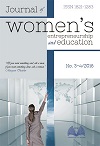Strategies for the Professional Development of Executive Women: Empirical Evidence in Latin America
Main Article Content
Abstract
This study identifies the main strategies used by women in order to access executive positions and to increase their professional development using the Latin American case. The study was conducted with 20 women executives who work in large companies in Lima, Peru. The analysis in the Latin American context adds more empirical information with regard to the executive women in a context that is not studied in depth so far. It is important to analyze Latin America because there are inequities in the use of time by men and women, mainly in the case of the unpaid productive work, since the unpaid work activities are mainly designated to women.
The results show that the executive women seem to identify the development strategies that were proposed according to the theoretical basis of this study. The results also show that the main strategies that executive women use are: networking; the support of a leader who guides the development process and is considered as a reference; education; and the overall experience. In addition, other identified strategies were the development of specific skills and competences for the activity, the search for a challenging work, making important decisions with determination, the “hard work”, and the passion for what they do. In all cases, the respondents’ innate leadership prevailed and they were willing to accept personal and work challenges which would allow them to grow professionally during their personal and work experience.
Article Details
Section
Once the manuscript is accepted for publication, authors shall transfer the copyright to the publisher. If the submitted manuscript is not accepted for printing by the journal, the authors shall retain all their rights. The following rights on the manuscript are transferred to the publisher, including any supplementary materials and any parts, extracts or elements of the manuscript:
- the right to reproduce and distribute the manuscript in printed form, including print-on-demand;
- the right to print prepublications, reprints and special editions of the manuscript;
- the right to translate the manuscript into other languages;
- the right to reproduce the manuscript using photomechanical or similar means including, but not limited to photocopy, and the right to distribute these copies;
- the right to reproduce and distribute the manuscript electronically or optically using and all data carriers or storage media, and especially in machine readable/digitalized form on data carriers such as hard drive, CD-ROM, DVD, Blu-ray Disc (BD), Mini Disc, data tapes, and the right to reproduce and distribute the article via these data carriers;
- the right to store the manuscript in databases, including online databases, as well as the right to transmit the manuscript in all technical systems and modes;
- the right to make the manuscript available to the public or to closed user groups on individual demand, for use on monitors or other readers (including e-books), and in printable form for the user, either via the Internet, online service, or via internal or external networks.
Authors reserve the copyright to published articles and have the right to use the article in the same manner like third parties in accordance with the licence Attribution-Non-Commercial-Non-Derivate 4.0 International (CC BY NC ND). Thereby they must quote the basic bibliographic data of the source article published in the journal (authors, article title, journal title, volume, pagination).
